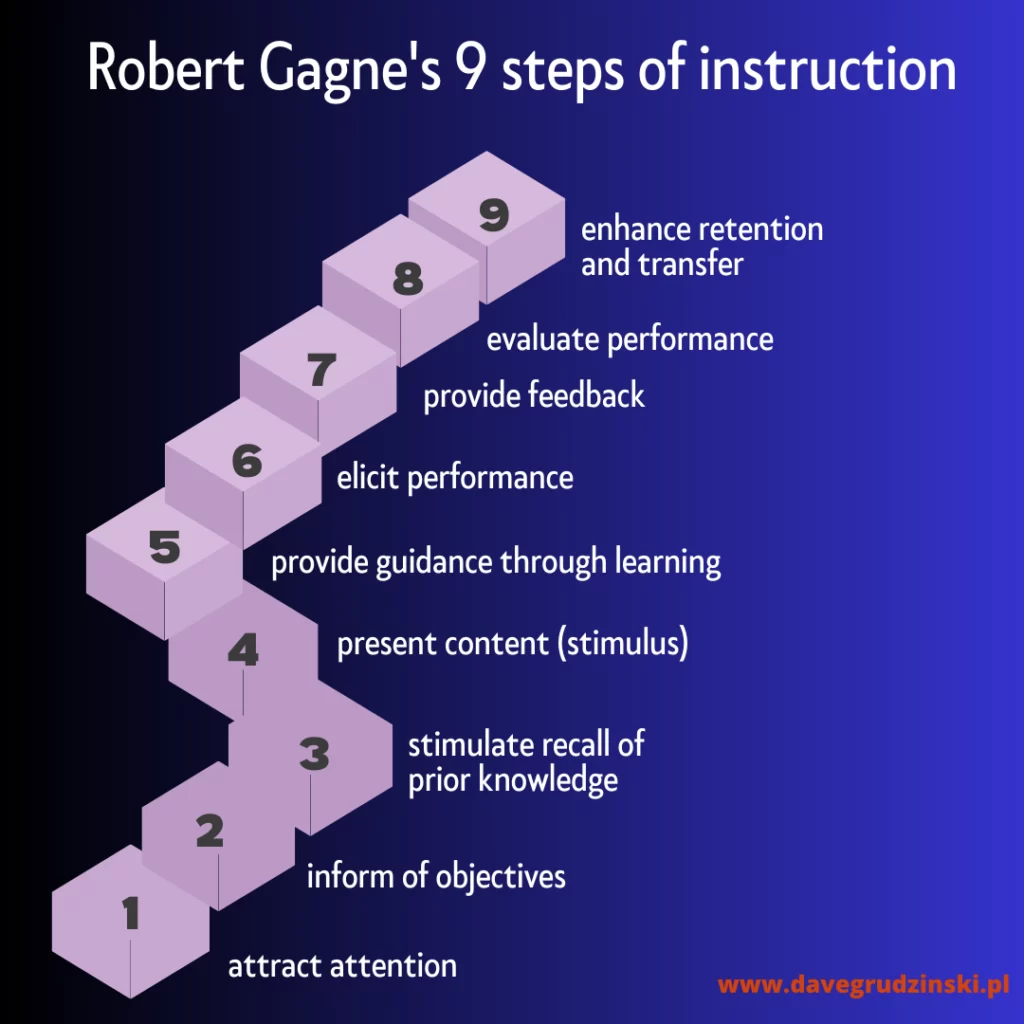Learning has a structure falling into a number of levels. Robert Gagne, an American psychologist, established a nine-step learning model. It’s sometimes referred to as Gagne’s 9 events of instruction. Although the theory dates back to 60s, it still stands.
9 events of instruction: attract attention
Nowadays what poses a challenge is make people want to learn. One of the reasons is we’re being bombarded with so many stimuli that there is barely anything that surprises us. No matter how great a class or a course is, they’re not going to be successful unless participants are interested. So how to attract learners’ attention before they begin to learn new stuff? There are lots of ways to do so. For instance, you might display an animation, a short movie from the course, an interactive image or just tell a story that corresponds to the course content. If you’re running a class, you might display a funny video footage.
Inform of the objectives
According to Gagne, learners need to know what they’re going to learn in a course. In other words, if you don’t tell them how they will benefit from the course, they might turn away from taking part in it. Understanding “why” they should take the course or a lesson will help them go through it. Moreover, from the trainer’s perspective, understanding the purpose of the course is an essential step before moving on to the “what” and “how”.
Stipulate the recall of prior knowledge
Learning is an incremental and iterative process. Note that lessons are much more effective if they’re based on the previous ones. Most of the class should relate to something that the learner has already learnt before. Obviously, it doesn’t mean the content should be identical. One can practice the same stuff in different modifications and ways. In order for learning to be effective, the learner has to know the fundamentals they might lean on before picking up new skills. The less new stuff during a class, the easier for the learner to catch up. Having said that, it’s recommended to start a course with a short warm-up that’s basic stuff.
Present content
This is “the body” of the course. Ideally if it’s divided into sections and laid out in chunks. The learner should have the impression they make any progress after each part. By progress I don’t mean moving through particular sections. Rather, I mean they learnt anything new. It’s great if the same learning content is put forward in different ways: video, text, listening, images, presentation and so on. Any appearing content should be practiced over by the learner. Suppose I introduce new English vocabulary, will you benefit from it being only displayed without practicing it in subsequent exercises? I don’t think so.
Provide guidance through learning
Little are learners taught how to learn, which is a big mistake. Learning is much more effective if they not only are aware of it, but also take the ownership of it. It’s hard to own a learning process without understanding how to learn; therefore, it’s an instructor’s task to provide them with insight on how to use the materials they provide them with. What’s more, the learner’s should also be empowered with some tools to make use of. At this point, I pretty often meet with change resistance. “That’s not the way I was taught”, they argue. I don’t impose, rather try to convince to try and experiment.
Elicit performance
To my way of thinking, we learn best and fastest while doing, trying, experimenting, and making mistakes. Why? Because this is where the rubber meets the road. Practice means we use the knowledge we have gained in a given context. Of course, it doesn’t mean you’re left alone from the beginning. The course might be designed in such a way that you develop your independence gradually.
Provide feedback
There are three reasons why feedback is important for both the trainer and the learner. Firstly, it gives the latter to learn about learning gaps and what needs to be improved. Secondly, it might direct the learner how to improve their performance, and last but not least, boost their zest for learning. It’s not convincing to progress when you don’t know where you are, so transparency is really important to be on the “right” track. Given the learner’s results, the instructor draw their conclusions from the course content, its layout, and so on.
Evaluate performance
Here comes the measurement of the course outcomes. That’s where the instructor gets its feedback concerning the effectiveness of the course. Analyzing the results of the participants and their remarks is really helpful to get better with future projects.
9 events of instruction: Enhance retention and transfer
Memorizing stuff just to forget it is a waste of time. To avoid that, provide the learner with the resources they might use without your assistance in the future. If it’s a programming course, you might provide the learner with links they might do their own projects using knowledge and skills paid out in your course. This is the time for the learner to apply this knowledge in their future activities.

